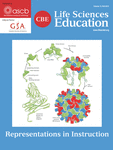Societies Coming Together in Support of Life Sciences Education
Since its founding more than 10 years ago, CBE–Life Sciences Education (LSE) has become the go-to place for biology education research and scholarship. Although the journal has always cultivated a broad range of authors, reviewers, and editors, we are pleased to announce that the Genetics Society of America (GSA) will be joining the American Society for Cell Biology (ASCB) as an editorial partner in support of the journal, while ASCB will remain the publisher of LSE.
The challenge of improving science education, both nationally and internationally, is a critical priority and a long-standing focus for both ASCB and GSA. We feel that scientific societies such as ours have an essential role to play here because together our collective expertise and energy can have a significant impact on science education across campuses and national boundaries (Alberts, 2012).
Ironically, we live in a time when research science has never had so many opportunities or so many challenges. Plummeting budgets are one threat, but an even bigger challenge is the training of a skilled scientific workforce and a scientifically educated public. From K–12 to secondary to higher education and lifelong learning, science education is in desperate need of data-driven reform, reinvestment, and reinvigoration. ASCB and GSA believe that there is neither time nor room for flag planting and parochialism. Rather than remaining only in our own silos, we will be more effective together, so we must join forces now.
Both GSA and ASCB have long promoted their own educational programs, but together we can synergize our efforts, where appropriate and feasible, to expand the knowledge base about the most effective approaches to teaching and learning in the life sciences. The majority of the articles published in LSE are not specific to teaching cell biology, genetics, or even biology. LSE delivers new data and new thinking about teaching in all the life sciences and, indeed, about teaching in other scientific disciplines.
What we mean by editorial partnership is a tight collaboration between our societies. Both organizations will contribute suggestions for the composition of LSE's joint editorial board, while leaving final decisions to the editor-in-chief, currently Erin Dolan, who has been an outstanding editor and leader in science education. In addition, ASCB and GSA will join forces to support LSE's already high editorial, ethical, and operational standards. Further, GSA and ASCB will both promote the journal, soliciting manuscripts and expanding readership. As an editorial partner, GSA will contribute to the costs of journal operations, which will continue to reside within ASCB.
This editorial partnership between ASCB and GSA is especially critical because most of our members are scientist-educators. Much of what appears in LSE has direct application to classroom practice, yet academic scientists have little time to keep up with the science education literature. We see LSE putting that critically needed information into the right hands, issue after issue.
GSA will continue its own activities to serve the members of the genetics community. This includes a new article type in GSA's flagship journal, Genetics, called “Primers,”1 which is designed to bring cutting-edge scientific research into the classroom by making scientific papers accessible to undergraduate students and instructors (Hawley and Ruedi, 2012). Primers will complement original research articles published in the same or a recent issue of Genetics, providing background on concepts and approaches, along with suggestions for using the articles in the classroom. GSA is also developing its Peer-Reviewed Education Portal (GSA PREP) as a repository for fully vetted teaching materials from and for science educators.2 GSA offers a variety of career development sessions at its meetings and has recently added students and postdocs to each of its committees and as advisory representatives to the GSA board.
One of ASCB's core activities is to develop high-quality educational materials and provide professional development opportunities for young scientists. For example, ASCB is strengthening its world-renowned iBiology video program,3 offers enhanced educational webinars year-round, and added a new professional development thread at its annual meeting this coming December in New Orleans. ASCB has also recently established a new Committee for Postdocs and Students, or COMPASS, to weave trainee members more closely into the fabric of ASCB.
ASCB is particularly pleased to join forces with GSA. A jointly supported LSE will give us a common scholarly base on which both societies can plan new educational initiatives. As executive directors of ASCB and GSA, we today raise the standard of our new editorial partnership in LSE, hoping that it might inspire others to join with us or create similar partnerships. As scientists, the members of GSA and ASCB believe that our work both at the bench and in the classroom should be guided by data and evidence-based best practices. That is what LSE is all about. And with GSA and ASCB together on the masthead, we can help provide a larger and more inclusive forum for sharing important research in science education.



